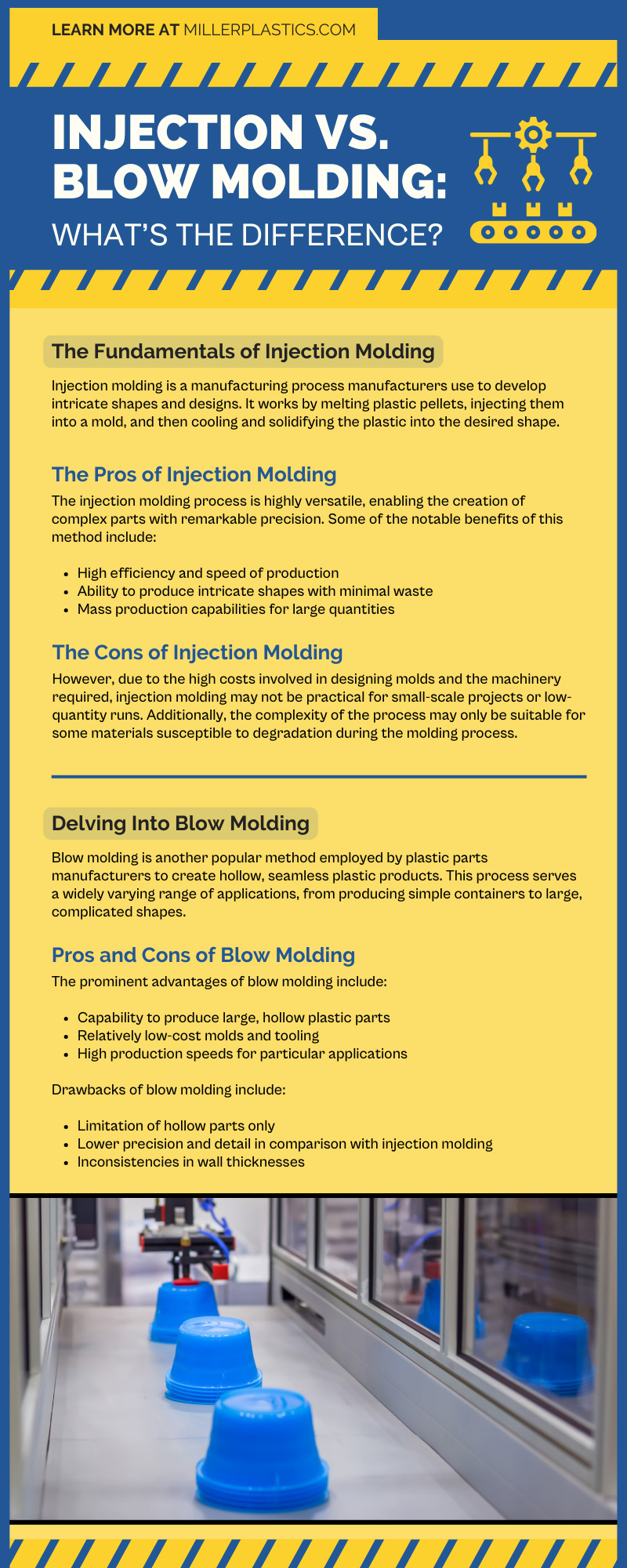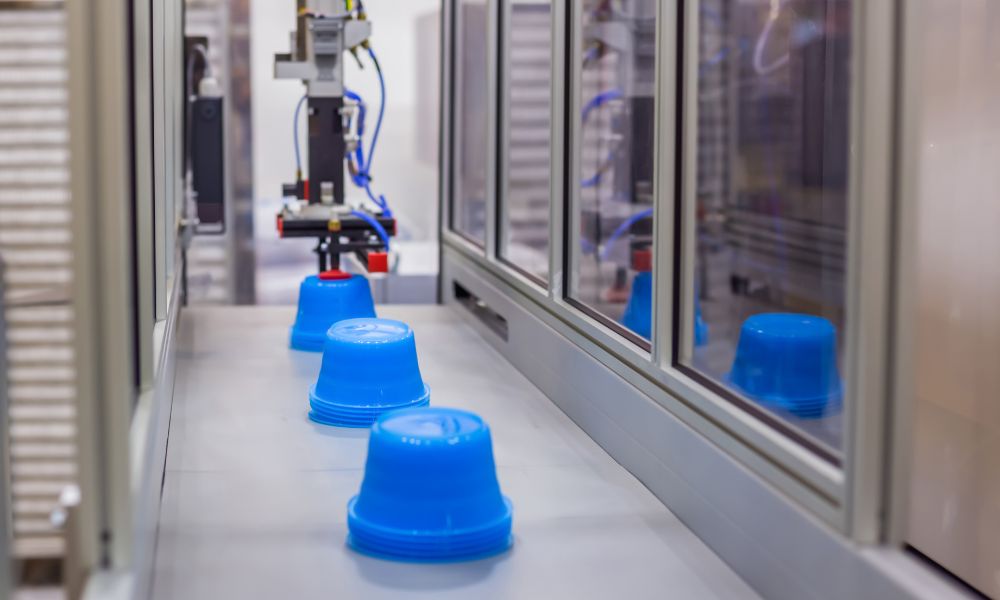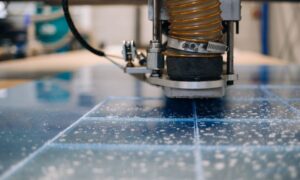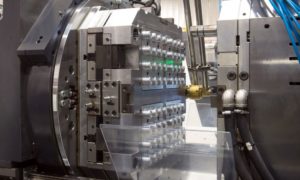In manufacturing, producing quality plastic parts is essential for many industries. Two primary methods have gained prominence in accomplishing this task: injection and blow molding. However, understanding the distinctions between these unique techniques is crucial for determining the best-suited application for your needs.
In this comprehensive guide, we will explore the characteristics, uses, and limitations of injection and blow molding while emphasizing their advantages, drawbacks, and optimal employment scenarios. By learning these things, you’ll have more information to help you choose the right method for creating your custom plastic parts.
The Fundamentals of Injection Molding
Injection molding is a manufacturing process manufacturers use to develop intricate shapes and designs. It works by melting plastic pellets, injecting them into a mold, and then cooling and solidifying the plastic into the desired shape. Here’s a step-by-step outline of the procedure.
- Place plastic pellets into a heated barrel to melt the plastic and initiate the molding process.
- Mix the molten plastic and force it into a mold cavity, giving the plastic shape and form to achieve the desired dimensions and features.
- After injection, the molten plastic undergoes cooling, gradually solidifying to acquire stability and rigidity for the final product. Once the plastic cools, open the mold to reveal the solidified plastic part.
- Carefully eject the finished part from the mold. It’s now ready for further processing or use in various applications.
The Pros of Injection Molding
The injection molding process is highly versatile, enabling the creation of complex parts with remarkable precision. Some of the notable benefits of this method include:
- High efficiency and speed of production
- Ability to produce intricate shapes with minimal waste
- Mass production capabilities for large quantities
The Cons of Injection Molding
However, due to the high costs involved in designing molds and the machinery required, injection molding may not be practical for small-scale projects or low-quantity runs. Additionally, the complexity of the process may only be suitable for some materials susceptible to degradation during the molding process.
Delving Into Blow Molding
Blow molding is another popular method employed by plastic parts manufacturers to create hollow, seamless plastic products. This process serves a widely varying range of applications, from producing simple containers to large, complicated shapes. Blow molding functions in the following manner:
- To start, manufacturers suspend a heated plastic tube called a parison between two mold halves, creating a crucial foundation for subsequent steps.
- Once in position, machines introduce compressed air, inflating the tube to conform precisely to the mold walls. This controlled inflation ensures the desired form and structure of the final product.
- As the part takes shape, it gradually cools and solidifies, acquiring strength and integrity. The contact between the parison and the mold surface facilitates the cooling and solidification process, shaping and hardening the material.
- Finally, after the cooling process, the mold halves separate, allowing for easy removal of the finished part. This step marks the culmination of the molding process, resulting in a meticulously crafted product ready for further refinement or use.
Pros and Cons of Blow Molding
The prominent advantages of blow molding include:
- Capability to produce large, hollow plastic parts
- Relatively low-cost molds and tooling
- High production speeds for particular applications
Drawbacks of blow molding include:
- Limitation of hollow parts only
- Lower precision and detail in comparison with injection molding
- Inconsistencies in wall thicknesses
Comparing Injection and Blow Molding
Understanding the inherent differences between these two processes allows you to determine the best technique for your specific application. Below are a few crucial factors to consider.
Application Requirements
The product’s desired shape, size, and complexities are pivotal in determining the most appropriate manufacturing technique. Injection molding generates intricate, solid parts, while blow molding is well-suited for simpler, hollow structures. For example, injection molding would be ideal for creating gears or enclosures, whereas blow molding would be perfect for items such as bottles or tanks.
Material Compatibility
The thermoplastics that are useful for injection molding or blow molding can vary significantly. Analyze the material requirements of your project and consult with a custom plastic parts manufacturer to assess the compatibility of the desired technique with the selected material. Certain materials might exhibit superior performance with either injection or blow molding. For instance, while polypropylene and polyethylene work well with both techniques, materials such as polystyrene or polyvinyl chloride (PVC) are more compatible with injection molding due to their thermoplastic properties.
Time Constraints
If speed is a crucial factor in your project, injection molding may be more suitable, as it typically has shorter production cycles than blow molding processes. However, the time required for tooling and mold preparation in the injection molding process can be significantly longer, especially for complex parts. It’s important to factor in these preparation times when considering production schedules and deadlines.
Production Volume
If your project requires a large production volume, injection molding offers a more efficient and cost-effective option. However, if your project calls for lower quantities or prototype runs, blow molding may be the better choice. For one-off productions or small batches, the lower tooling costs of blow molding can offer a more economical solution. In contrast, injection molding is more suitable for high-volume production due to its ability to produce precise and complex parts quickly.
Cost Considerations
Your budget will have a large sway over your decision in the end, as you need to balance upfront costs and long-term savings with what you can afford. Blow molding is the right choice if your budget limits how much you can spend. But injection molding is better for any long-term production, as you pay more upfront but save more money the longer your production lasts.
Overall, both techniques have distinct advantages and limitations you should evaluate before making a final decision.
Industries That Use Injection and Blow Molding
Both injection and blow molding serve critical roles in various industries, including the following.
- Medical: Creating precision medical devices with high-quality materials and stringent manufacturing requirements
- Packaging: Manufacturing a wide array of containers for food, beverages, cosmetics, and many other consumer products
- Automotive: Designing vehicle parts such as bumpers, dashboards, and door trims using specialized thermoplastics
- Consumer Goods: Producing plastic products such as toys, household items, and office supplies.
- Aerospace: Manufacturing complex parts with specific material properties capable of withstanding extreme conditions
Both blow and injection molding have many differences, making it critical to assess your project’s unique needs before settling on either technique. With this guide’s insights, we hope you can make an informed decision when choosing between these two methods for your next custom plastic part project.





